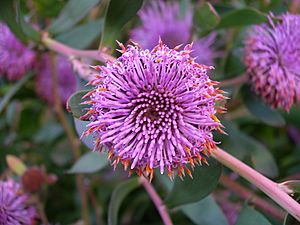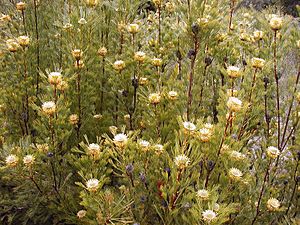Isopogon facts for kids
Quick facts for kids Isopogon |
|
|---|---|
 |
|
| Isopogon cuneatus | |
| Scientific classification |
|
| Kingdom: | Plantae |
| Clade: | Tracheophytes |
| Clade: | Angiosperms |
| Clade: | Eudicots |
| Order: | Proteales |
| Family: | Proteaceae |
| Subfamily: | Proteoideae |
| Tribe: | Leucadendreae |
| Subtribe: | Isopogoninae |
| Genus: | Isopogon R.Br. ex Knight |
| Type species | |
| Isopogon anemonifolius |
|
| Species | |
|
39 species (see text) |
|
 |
|
| Occurrence data from Australasian Virtual Herbarium | |

Isopogon, often called conesticks, conebushes, or coneflowers, is a group of about forty types of flowering plants. These plants belong to the Proteaceae family. They are found only in Australia, meaning they are endemic there. Isopogon plants are shrubs with stiff leaves. Their flowers grow in a tight spike or "cone." The fruit is a small, hairy nut.
Contents
What Isopogon Plants Look Like
Isopogon plants are shrubs that can grow upright or spread along the ground. They have stiff leaves, which are usually compound. This means each leaf is made up of several smaller parts. Sometimes, the leaves are simple, meaning they are just one piece.
The compound leaves are deeply divided. Their parts can be flat or shaped like cylinders. The flowers usually grow at the ends of the branches. They are often surrounded by special leaves called bracts. The flowers form a shape that looks like a cone or a ball.
Each flower has both male and female parts (it's bisexual). The flower parts, called tepals, spread open as the flower grows. The lower part of the flower stays on the plant until the fruit gets bigger. The fruits then join together to form a woody, cone-like structure. Each fruit is a nut. The bracts eventually fall off, releasing the fruit. Isopogon plants have 13 haploid chromosomes, which are like tiny packages of genetic information.
How Isopogon Plants Are Named and Classified
The group of plants called Isopogon was first officially described in 1809. This was done by a gardener named Joseph Knight. He wrote about it in his book, On the cultivation of the plants belonging to the natural order of Proteeae. Another botanist, Robert Brown, also wrote about the same plants in his book, On the natural order of plants called Proteaceae. Knight's description came out just before Brown's.
Different Types of Isopogon Species
Here is a list of the different types of Isopogon plants. This list includes species, subspecies, and varieties. It was accepted by the Australian Plant Census in November 2020:
- Isopogon adenanthoides Meisn. (W.A.) - spider coneflower
- Isopogon alcicornis Diels (W.A.) - elkhorn coneflower
- Isopogon anemonifolius (Salisb.) Knight (N.S.W.) - broad-leaved drumsticks
- Isopogon anethifolius (Salisb.) Knight (N.S.W.) - narrow-leaved drumsticks
- Isopogon asper R.Br. (W.A.)
- Isopogon attenuatus R.Br. (W.A.)
- Isopogon axillaris R.Br. (W.A.)
- Isopogon baxteri R.Br. (W.A.) - Stirling Range coneflower
- Isopogon buxifolius R.Br. (W.A.)
- Isopogon buxifolius R.Br. var. buxifolius
- Isopogon buxifolius var. obovatus (R.Br.)Benth.
- Isopogon ceratophyllus R.Br. (S.A., Vic., Tas.) - wild Irishman, horny cone bush
- Isopogon crithmifolius F.Muell. (W.A.)
- Isopogon cuneatus R.Br. (W.A.) - coneflower
- Isopogon dawsonii F.Muell. ex R.T.Baker (N.S.W.) - Nepean cone bush
- Isopogon divergens R.Br. (W.A.) - spreading coneflower
- Isopogon drummondii Hügel ex Jacques (W.A.)
- Isopogon dubius (R.Br.) Druce (W.A.) - pincushion coneflower
- Isopogon fletcheri F.Muell. (N.S.W.) - Fletcher's drumsticks
- Isopogon formosus R.Br. (W.A.) - rose coneflower
- Isopogon formosus subsp. dasylepis (Meisn.) Foreman
- Isopogon formosus R.Br. subsp. formosus
- Isopogon gardneri Foreman (W.A.)
- Isopogon heterophyllus Meisn. (W.A.)
- Isopogon inconspicuus (Meisn.) Foreman (W.A.)
- Isopogon latifolius R.Br. (W.A.)
- Isopogon linearis Meisn. (W.A.)
- Isopogon longifolius R.Br. (W.A.)
- Isopogon mnoraifolius McGill. (N.S.W.)
- Isopogon panduratus Hislop & Rye (W.A.)
- Isopogon panduratus subsp. palustris Hislop & Rye
- Isopogon panduratus Hislop & Rye subsp. panduratus
- Isopogon petiolaris R.Br. (Qld., N.S.W.)
- Isopogon polycephalus R.Br. (W.A.) - clustered coneflower
- Isopogon prostratus McGill. (N.S.W., Vic.) - prostrate cone-bush
- Isopogon pruinosus Hislop & Rye (W.A.)
- Isopogon pruinosus subsp. glabellus Hislop & Rye
- Isopogon pruinosus Hislop & Rye subsp. pruinosus
- Isopogon robustus Foreman ex N.Gibson (W.A.)
- Isopogon scabriusculus Meisn. (W.A.)
- Isopogon scabriusculus subsp. pubifloris Foreman
- Isopogon scabriusculus Meisn. subsp. scabriusculus
- Isopogon scabriusculus subsp. stenophyllus Foreman
- Isopogon spathulatus R.Br. (W.A.)
- Isopogon sphaerocephalus Lindl. (W.A.) - drumstick isopogon
- Isopogon teretifolius R.Br. (W.A.) - nodding coneflower
- Isopogon tridens (Meisn.) F.Muell. (W.A.) - three-toothed coneflower
- Isopogon trilobus R.Br. (W.A.) - barrel coneflower
- Isopogon uncinatus R.Br. (W.A.)
- Isopogon villosus Meisn. (W.A.)
Two new types of Isopogon have been found recently. These are I. autumnalis (described in December 2019) and I. nutans (described in May 2020). However, these names were not yet officially accepted by the Australian Plant Census as of November 2020.
See also
 In Spanish: Isopogon para niños
In Spanish: Isopogon para niños


